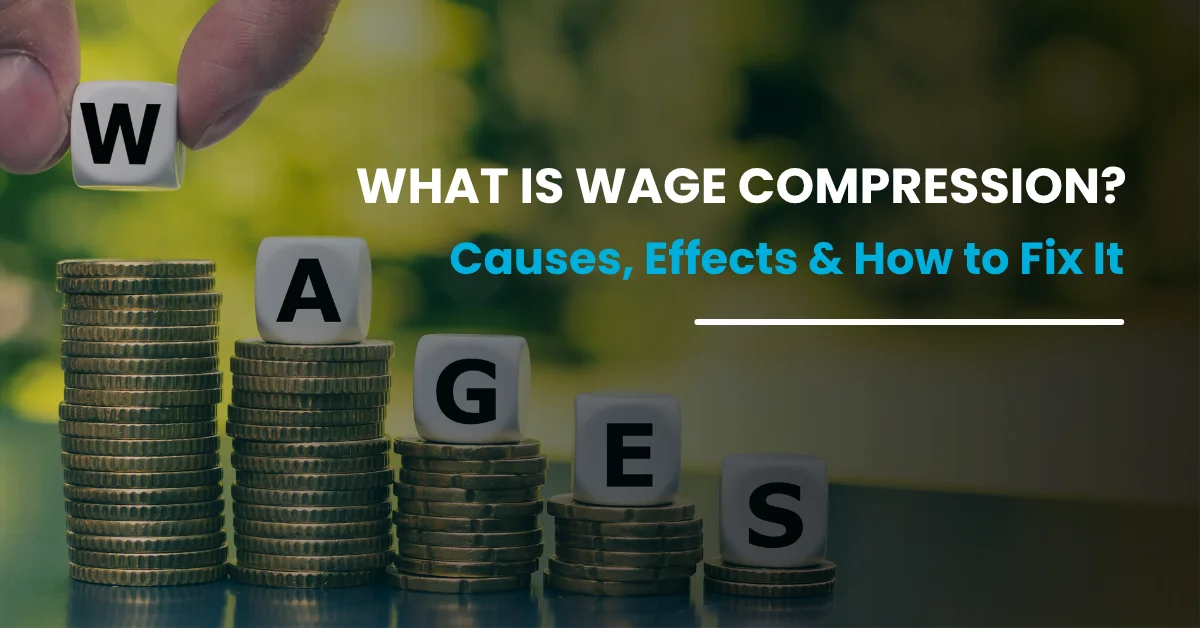Wage compression is silently wreaking havoc in organizations across America. According to a 2022 survey, 56% of organizations experienced pay or wage compression in the last year, yet most companies don’t realize they have a problem until their best employees start walking out the door.
With the average turnover rate settling at 18% in 2024, understanding wage compression isn’t just an HR nice-to-have—it’s essential for keeping your workforce intact. This comprehensive guide breaks down everything you need to know about wage compression, from identifying the warning signs to implementing solutions that actually work.
Let’s dive into why your experienced employees might be earning barely more than yesterday’s new hires, and what you can do about it.
What is wage compression? Understanding the pay compression definition
What is wage compression exactly? Simply put, wage compression occurs when the salary gap between new hires and experienced employees becomes uncomfortably narrow. The pay compression definition centers on this core issue: newly hired, less-experienced workers earning close to what seasoned employees make for similar roles.
The pay compression definition extends beyond just salary numbers. It represents a fundamental breakdown in how organizations value experience, tenure, and skill development. Wage compression typically happens when market rates for starting salaries increase faster than companies can afford to give raises to existing staff.
Key characteristics of wage compression
Understanding the pay compression definition requires recognizing these telltale signs:
- Minimal pay differences between entry-level and experienced positions
- New hires earning within 10 to 15% of veteran employees in similar roles
- Skills and experience not reflected proportionally in compensation packages
- Market rate inflation outpacing internal salary adjustments
Common scenarios where wage compression occurs
Wage compression doesn’t happen overnight. The pay compression definition becomes reality through these typical scenarios:
- Market rate increases that outpace internal budget allocations
- Competitive hiring in tight labor markets driving up starting salaries
- Minimum wage increases that compress the entire salary structure
- Industry talent shortages forcing higher entry-level compensation
The pay compression definition also includes situations where employees most affected by minimum wage laws are compensated at rates that squeeze middle-tier salaries, creating a domino effect throughout the organization.
Why does wage compression happen? Root causes explained
Wage compression doesn’t appear randomly—it’s the result of specific market and organizational factors. Understanding these causes helps you prevent wage compression before it damages employee morale and retention.
Market-driven factors
External forces play a major role in creating wage compression:
- Rising market rates for new hires in competitive industries
- Industry talent shortages driving up starting salaries dramatically
- Economic inflation affecting compensation benchmarks
- Geographic shifts in salary standards across regions
When the market rate for starting salaries increases faster than organizations can afford to give raises to existing employees, wage compression often results. This market-driven wage compression particularly affects high-demand fields like technology and healthcare.
Internal company factors
Organizational decisions directly contribute to wage compression:
- Lack of regular salary reviews for existing employees
- Budget constraints limiting merit increases and promotions
- Poor compensation strategy implementation across departments
- Inconsistent pay policies between hiring and retention
Which practice helps to avoid problems with pay compression?
Which practice helps to avoid problems with pay compression most effectively? The answer lies in proactive compensation management:
- Regular market analysis and salary benchmarking against industry standards
- Structured compensation reviews conducted annually or bi-annually
- Proactive pay equity audits that identify compression before it worsens
- Performance-based advancement programs that reward experience appropriately
Which practice helps to avoid problems with pay compression comes down to treating compensation as a strategic investment rather than just a cost center.
How wage compression affects your organization
Wage compression creates ripple effects that extend far beyond payroll numbers. The impact on organizational health can be devastating if left unchecked.
Impact on employee morale and retention
Wage compression directly attacks the foundation of employee satisfaction:
- Decreased job satisfaction among experienced workers who feel undervalued
- Higher turnover rates as veteran employees seek better compensation elsewhere
- Loss of institutional knowledge when experienced staff leave
- Reduced loyalty toward the organization and its mission
Studies show that 31% of employees leave their jobs within the first six months, and wage compression accelerates this trend by making experienced employees feel their tenure isn’t valued.
Effects on productivity and performance
The pay compression definition includes these performance consequences:
- Reduced motivation among senior employees who see no financial benefit to experience
- Difficulty attracting top-tier talent who research internal pay scales
- Negative impact on company culture and team dynamics
- Decreased mentorship as experienced workers become disengaged
Financial consequences for employers
Wage compression hits the bottom line through multiple channels:
- Higher recruitment costs as turnover increases
- Training expenses for constant new hire onboarding
- Lost productivity during employee transitions and knowledge gaps
- Reputation damage affecting future hiring efforts
With turnover rates averaging 17.3% nationally, wage compression can push your organization well above this benchmark, significantly increasing operational costs.
How to identify wage compression in your company
Spotting wage compression early requires systematic analysis and attention to employee feedback. The pay compression definition becomes clear when you know what to look for.
Warning signs and red flags
Wage compression manifests through these observable indicators:
- New hires earning 90% or more of what experienced employees make
- Veteran employees expressing dissatisfaction with compensation
- Higher turnover among senior staff compared to entry-level workers
- Difficulty filling middle-management and experienced positions
Data analysis techniques
Combat wage compression with these analytical approaches:
- Salary range analysis comparing pay scales by experience level
- Market rate comparisons using industry benchmarking data
- Internal equity assessments examining pay fairness across departments
- Tenure-to-salary ratios identifying compression patterns
The pay compression definition becomes actionable when backed by solid data analysis that reveals where your organization stands compared to market standards.
How to fix wage compression: Proven solutions
Addressing wage compression requires both immediate action and long-term strategic planning. The pay compression definition includes not just the problem, but the pathway to resolution.
Immediate action steps
Wage compression demands urgent attention through these initial measures:
- Comprehensive pay equity audit identifying all affected employees
- Priority adjustments for critical roles and high performers
- Budget reallocation to address the most severe compression cases
- Communication strategy explaining the correction process to employees
Ensure that employees most affected by minimum wage laws are compensated fairly within your broader compression correction strategy.
Long-term prevention strategies
Sustainable wage compression solutions require systematic changes:
- Regular market analysis and benchmarking every 6 to 12 months
- Structured merit increase programs based on performance and tenure
- Clear career progression frameworks with defined salary advancement
- Retention bonuses for key employees during market transitions
What is considered a bad salary strategy vs. effective approaches
Understanding salary inversion what is considered a bad salary practice helps avoid common mistakes:
Bad Salary Strategies:
- Across-the-board increases that don’t address individual compression
- Ignoring market rates when setting internal pay scales
- Reactive adjustments only when employees threaten to leave
- Inconsistent policies between departments and roles
Effective Approaches:
- Performance-based adjustments that reward results and experience
- Transparent compensation structures with clear advancement paths
- Regular benchmarking against industry and geographic standards
- Proactive retention strategies for high-value employees
Budget-friendly solutions
Wage compression solutions don’t always require massive budget increases:
- Phased salary adjustments spread over 12 to 18 months
- Non-monetary compensation improvements like flexible work arrangements
- Professional development opportunities that add value beyond salary
- Recognition programs that acknowledge experience and contributions
Best practices to prevent future wage compression
Prevention beats correction when dealing with wage compression. The pay compression definition should guide your proactive strategies.
Wage compression prevention requires these ongoing practices:
- Annual compensation reviews with market rate adjustments
- Transparent pay structures that employees understand and trust
- Performance-based advancement opportunities tied to clear metrics
- Regular communication about compensation philosophy and changes
Wage compression becomes manageable when treated as an ongoing strategic priority rather than a crisis to resolve.
Conclusion
Wage compression threatens organizational stability, but it’s preventable with the right approach. Addressing wage compression requires expertise most organizations lack internally.
Team GPS provides comprehensive compensation management solutions that eliminate wage compression before it damages your workforce. Our platform delivers real-time market analysis and automated pay equity monitoring.
Ready to solve wage compression?
Book a free Team GPS demo for compensation strategy workshop and discover how leading companies are building stronger, more engaged teams.











